Last Updated on January 9, 2024 by Greg Gillson
Did you see a brightly-colored red bird, orange bird, or yellow bird in Texas and wonder what is was?
This page is for you!
This article shows you photos and identification of some of the most common birds in Texas based on color.
The list of birds found in Texas includes over 675 species. So, I can’t show you all of them. I’m going to assume that you saw a common bird of this color, but you certainly could have seen something less common, or even rare!
Shape (including the shape of the bill) and size are often more helpful in starting to identify a bird than the color. In fact, most birds in North American can be easily identified with a black-and-white photo!
Many birds are multi-colored, so that it may be hard to pick out a dominant color. Males and females may be colored quite differently. And some color patterns are similar among otherwise dissimilar species.
Nevertheless, I’m going to try to pick out some of the birds that you are most likely to see in backyards or towns. And I’ll show a few others that I get asked about a lot.
The birds with a noticeable amount of red on them in Texas covered in this article are:
- Vermilion Flycatcher
- Northern Cardinal
- House Finch
- American Robin
- Summer Tanager
- Pyrrhuloxia
The birds with a noticeable amount of orange on them in Texas covered in this article are:
- Ruddy Duck
- Orchard Oriole
- Bullock’s Oriole
- Barn Swallow
- Spotted Towhee
- American Redstart
The birds with a noticeable amount of yellow on them, including lots of yellow and black birds, in Texas covered in this article are:
- Yellow-rumped Warbler
- Cedar Waxwing
- American Goldfinch
- Lesser Goldfinch
- Eastern Meadowlark
- Common Yellowthroat
- Western Kingbird
- Yellow Warbler
- Nashville Warbler
- Wilson’s Warbler
- Northern Flicker (Yellow-shafted)
- Great Crested Flycatcher
- Yellow-breasted Chat
Red birds of Texas
Birds get the red, orange, and yellow in their feathers from carotenoids in the fruit, seeds, and plants they eat (source).
These carotenoid colors combine with melanin to form an infinite range of red feathers–pink, rusty, scarlet, violet, red-orange.
The following are red birds that you are most likely to see in Texas.
Vermilion Flycatcher
These small desert birds are a glowing hurt-your-eyes red!
 |
| Male Vermilion Flycatcher. Greg Gillson. |
Males are brilliant red on the crown and underparts. The back, wings, and tail are dark sooty brown.
Females and immature birds are paler. They are more grayish brown above, white below with streaked breast and belly that may be peachy yellow to orange-pink.
They are found in deserts near water, pastures, golf courses, ball fields.
Vermilion Flycatchers are summer residents in western Texas, year-round residents in southmost Texas, and winter visitors along the Gulf coast.
Northern Cardinal
These are one of the most common backyard birds in the eastern United States. Their bright red color and unique head profile makes them instantly identifiable to most people–whether they are bird watchers or not!

Males of these large seed eaters are bright red with a black face and red crest.
Females replace most of the red with brown, The bill is large and orange.
These birds are found in woodlands, stream edges, residential areas.
Northern Cardinals are year round residents throughout Texas.
House Finch
When people ask about a bird with a red head at their feeder, it is usually this bird.
 |
| Male House Finch. Greg Gillson. |
Males of this dusty brown striped finch have red limited to the head (specifically the forehead and eyebrow), breast (chest), and rump. The red coloration tends toward orangish, and may rarely be yellowish.
Females are streaked, similar to the males but without red. They lack any strong pattern on the face and head.
Note the small round head and curved upper ridge on the bill.
Some people call these red-headed sparrows. Sparrows and finches are similar, but in general, male finches are brighter than the females and tend to hang out more in trees. Sparrow genders are usually quite similar in coloration and tend to feed mostly on the ground.
These birds are common in residential areas, especially at bird feeders. In the West more widespread in arid regions near water.
House Finches are year-round residents throughout Texas, rare right along the coast.
American Robin
These are familiar lawn birds with red breasts.
 |
| American Robin. Greg Gillson. |
Male American Robins are brownish-gray above with a brick red breast. Females are paler orange below and paler gray above.
They are widespread in open country with scattered deciduous trees, residential areas.
American Robins are year-round residents throughout most of Texas, winter visitors only along the border with Mexico.
Summer Tanager
These bright red birds are found toward the tops of tall trees in the southern United States.

Males are rose red with fairly heavy bill.
Females are yellowish or mustard-colored, some with a faint reddish wash.
In the East these birds are found in pine-oak woodlands. In the West they prefer tall cottonwood trees.
Summer Tanagers are summer residents in the eastern and southern parts of Texas.
Pyrrhuloxia
These gray and red desert birds are shaped like cardinals, to which they are related.
 |
| Pyrrhuloxia. Uploaded by berichard, CC BY 2.0, Link |
Males are pale gray with red highlights on face, crest, and chest.
Females are gray and buff-colored, with only a hint of red. The bill is yellowish and strongly curved on the culmen (upper ridge).
These birds are found in thorny desert scrub, such as mesquite, and also ranches.
Pyrrhuloxias are year-round residents in southwestern Texas, some movement northeastward in winter.
Orange birds of Texas
True orange-colored birds are not that common. Many birds that I have here are paler rusty.
The common pattern is an orange body and black or brown wings and tail. Another common pattern is for the orange to be restricted to the under parts.
The following are orange birds that you are most likely to see in Texas.
Ruddy Duck
These small ducks are dark rusty-orange in spring.
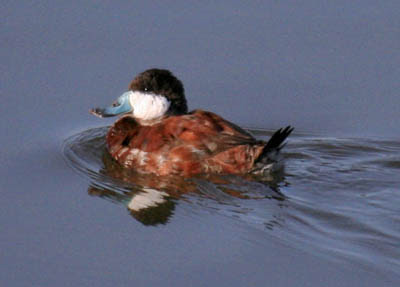 |
| Ruddy Duck. Greg Gillson. |
Males in breeding plumage (late winter and spring) are rusty, with a white face, and a blue bill. The long tail is often held sticking up. In winter they are brown, with white face, and dark bill.
Females all year are like winter males. Brown body, dark cap, dark line through eye of pale face. Dark bill.
These birds prefer weedy ponds to breed, but in winter may be found in deeper ponds in city parks.
Ruddy Ducks are winter visitors throughout Texas.
Orchard Oriole
Males of these orioles are darker rustier-orange than most other orioles in the United States.
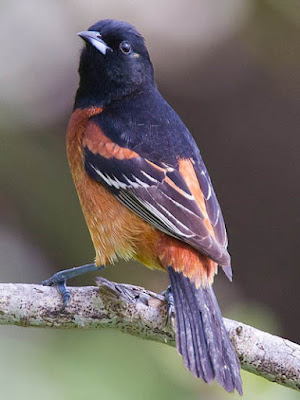 |
| Orchard Oriole. Dan Pancamo. Flikr. CC BY-SA 2.0 |
Males have a black hood and back, black wings and tail. The under parts are rusty-orange or even chestnut-brown.
Females are greenish above, lemon yellow below. They have 2 thin white wing bars. The bill is thinner than many other orioles.
They are found in orchards and residential shade trees.
Orchard Orioles are summer residents throughout most of Texas.
Bullock’s Oriole
These bright orange and black birds are often seen in tall trees.
 |
| Male Bullock’s Oriole. Greg Gillson. |
The males of this species are very bright orange. The back and top of the heads are black. The black wings have large white wing patches. The tail is black with orange sides. The face is orange with a black line through the eye and a black throat.
Females and young are gray with yellow head and breast and tail.
These birds are more common in drier inland regions along watercourses in tall cottonwoods or shade trees. Rarely come to feeders for fruit or nectar in spring.
Bullock’s Orioles are summer residents in the western half of Texas.
Barn Swallow
These orange-bellied birds are a familiar sight across North America in summer.
 |
| Barn Swallow. Greg Gillson. |
These birds are purple-blue above with orange under parts and long forked tails. The color of the underparts in winter or on females are often cinnamon or buff-colored, but breeding males can be brighter orange-red.
These birds swoop low over fields and wetlands at lower elevations. They may build their mud nests in rafters on porches, garages, or other out-buildings.
Barn Swallows are summer residents throughout Texas.
Spotted Towhee
These big sparrows with rusty-orange sides superficially resemble the coloration of robins.
 |
| Spotted Towhee. Greg Gillson. |
These birds have dark hoods and upper parts with rusty rufous-orange sides and white bellies. They have white spots over their wings, shoulders, and on their tail corners. The upper parts of the males are jet black, females dark brown. Some populations have paler orange sides.
These are somewhat shy birds that hide in the dense brush and spend most of their time on the ground. They visit feeders during quiet periods.
Spotted Towhees are year-round residents in westernmost Texas, winter visitors throughout most of Texas.
American Redstart
In flight these small warblers flash orange or yellow in the wing and based of the tail.
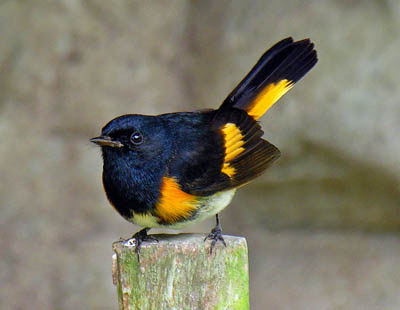 |
| American Redstart. Dennis Jarvis. Flikr. CC BY-SA 2.0 |
Males are black above, white on the belly. They have bright orange patches on side of breast, wings, and base of the tail.
Females are grayer, especially on the head/ The orange of males is replaced by yellow on the females.
These birds are found in regenerating woods after a clear cut, and willow tangles along streams.
American Redstarts are migrants in spring and fall throughout Texas. They are also summer residents in the far eastern part of Texas.
Yellow birds of Texas
Yellow is a common bird color! Often it is mixed with black and white plumage in birds.
Many birds with darker upper parts have yellow breast or belly.
The following are yellow birds you are most likely to see in Texas.
Yellow-rumped Warbler
These are abundant warblers across North America. Affectionately called “butter butts” by many birders, because of their bright yellow rumps that flash in flight.
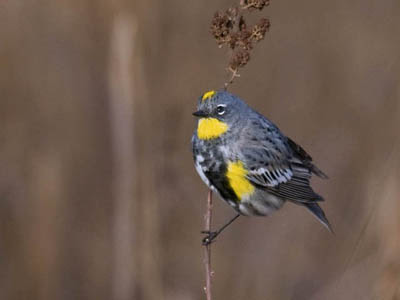 |
| Male Audubon’s Yellow-rumped Warbler. Greg Gillson. |
Western form (Audubon’s) with bright yellow throat and yellow rump. Large white wing patch.
Northern and Eastern form (Myrtle) with white throat, yellow rump, and two white wing bars.
Winter birds are dull gray brown, with bright yellow rump. Throat may be cream colored or white. Often difficult to tell the two forms apart in winter.
 |
| Winter Yellow-rumped Warbler. Greg Gillson. |
Breed in mountain or boreal conifers. Widespread in migration. Winter in low river bottoms, open weedy deciduous areas. Rarely come to feeders in winter.
Yellow-rumped Warblers are spring and fall migrants and winter visitors throughout Texas, the Audubon’s form more restricted to western Texas.
Cedar Waxwing
These crested birds with yellow band on the end of the tail are often found in flocks. They eat flying insects in summer, fruit and berries the rest of the year.
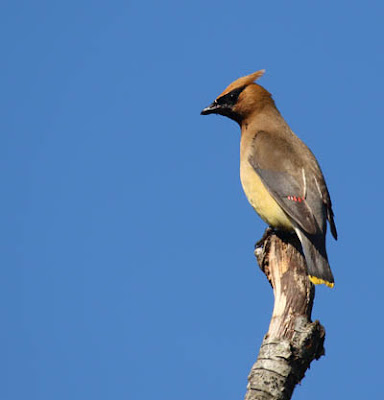 |
| Cedar Waxwing. Greg Gillson. |
These birds are fawn-brown above, with dark gray wings and tail. They have a black mask and wispy crest. The belly is yellow. The wings have waxy red drops on the end of the tertials. The end of the tail has a brilliant yellow tail band.
They are found in open habitats with berries, including juniper woodlands and towns in winter.
Cedar Waxwings are winter visitors throughout Texas.
American Goldfinch
These small little birds are bright yellow and black.
 |
| American Goldfinch. Greg Gillson. |
Males are bright lemon yellow with black and white wings and tail, black cap. White under tail coverts. Pink bill.
Females are duller yellow below and brownish above. Lack black cap.
Winter birds are pale brown or gray, a touch of yellow on the throat of males.
These are birds of open country, fields with saplings, clear cuts, residential areas. They avoid dense forests, mountains, deserts. They visit feeders.
American Goldfinches are winter visitors throughout Texas.
Lesser Goldfinch
Lesser Goldfinches maintain their bright yellow plumage all year–even in the winter when American Goldfinches are rather brown and colorless.
 |
| Male Lesser Goldfinch. Greg Gillson. |
These tiny birds are bright yellow below (including under the tail), and green or black on the back. The wings and tail are black and white. Males have a black cap, which the females lack.
These birds are found near water in arid regions of the West and Southwest. They are common in residential areas, too, and come to bird feeders.
Lesser Goldfinches are summer residents in the western half of Texas, year-round residents in the southwestern part of the state.
Eastern Meadowlark
These pale brown birds with the brilliant yellow breasts are home on the ground in prairies. They sing from perches on isolated trees, power poles, fence posts.
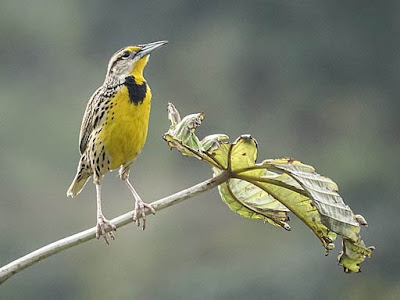 |
|
Eastern Meadowlark
Photo by Mike’s Birds from Riverside, CA, US [CC BY-SA 2.0]
|
The upper parts are streaked black, white, brown, so they blend into the dried grass where they live. The under parts are bright yellow with a black necklace across the chest. Very similar to Western Meadowlark, best told apart by spring song.
These birds live in prairies and extensive pasture lands.
Eastern Meadowlarks are year-round residents throughout most of Texas, winter visitors only in parts of central Texas.
Common Yellowthroat
These buttery yellow birds are abundant in the marsh vegetation.
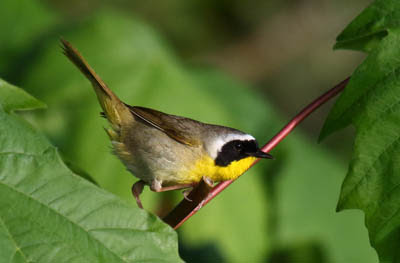 |
| Male Common Yellowthroat. Greg Gillson. |
These skulkers have bright yellow throats and yellow undertail coverts. Males have a black domino mask edged broadly in white, which females lack. Upperparts are dull olive-green.
Immature males in fall show a shadowed black mask.
Found in damp situations and heavy deciduous brambles following clear cuts.
Common Yellowthroats are winter visitors in the south half of Texas. They are year-round residents in the southeastern part of the state and the southwestern part along the Rio Grande River. Common Yellowthroats are summer residents only in the northeastern and panhandle parts of Texas. They are migrants only in the northwest-central part of the state.
Western Kingbird
These yellow-bellied birds of the prairies often perch on power lines and fence lines.
 |
| Western Kingbird. Greg Gillson. |
These birds are pale gray on the head and breast. Brown wings. The belly is lemon yellow. Black tail has white outer tail feathers, especially obvious in flight.
These are birds of prairies, deserts, pastures, often near water.
Western Kingbirds are summer residents throughout most of Texas, migrants only in the far eastern part of the state.
Yellow Warbler
The golden yellow sun packed all into one little bird! Appears to be an all-yellow bird.
 |
| Yellow Warbler. Greg Gillson. |
Some populations are bright yellow, some tend toward greenish on upper parts, some more golden. Yellow internal tail corners in flight.
Males with red breast streaking, again, variable by population.
Females somewhat to much paler yellow, some greenish, some whitish. Lack red streaks.
These birds are found in willow thickets on the edge of wetlands and ditches, stream sides in arid regions.
Yellow Warblers are spring and fall migrants only through Texas.
Nashville Warbler
These birds with the bright yellow underparts do a good job of hiding!
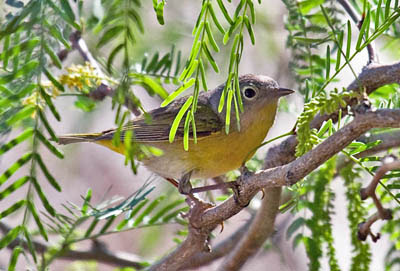 |
| Nashville Warbler. Greg Gillson. |
These birds are gray above. The throat and breast and under tail coverts are bright lemon yellow. The belly is white. They have a complete white eye ring.
Females are just a bit paler than males.
These birds are found in re-growing clear cuts, and understory brush in open woods.
Nashville Warblers are fall migrants throughout Texas, and spring migrants only in the eastern half of Texas. A few also winter in the southern tip of Texas.
Wilson’s Warbler
These bright yellow birds are very common, both on their summer territories and in migration.
 |
| Male Wilson’s Warbler. Greg Gillson. |
These birds are bright yellow in the West, more greenish above in the East. Only males have the black cap.
Both genders have a beady black eye in the middle of the yellow face.
These birds live in damp understory, tangles, willows.
Wilson’s Warblers are spring and fall migrants throughout Texas.
Northern Flicker
These woodpeckers spend much time eating ants on the ground.
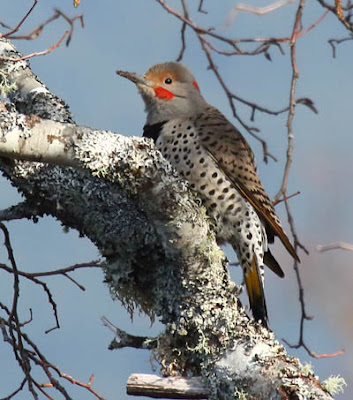 |
| Northern Flicker. Greg Gillson. |
These birds are larger than robins with brown and black barred upper parts. The underparts are pink with round black spots. There is a black crescent across the chest. When they fly away from you they reveal a large white rump.
Western birds have salmon-red under wings and under tail. Those in the East are colored yellow. The male face differs between the two populations–black whisker on the eastern birds, red whisker on western birds. Intergrades from overlap on Great Plains common. These may show male facial characteristics of both populations, or yellow-orange flight feathers.
These birds live in open woods with bare ground for foraging, residential yards.
Northern Flickers of the Eastern population with yellow flight feathers are year-round residents in northern Texas, winter visitors in eastern Texas. Intergrades are fairly common in western Texas.
Great Crested Flycatcher
These flycatchers have long tails and big heads with big bill and bright yellow belly.
 |
| Great Crested Flycatcher. Simard Francois. Pixabay. |
These birds are gray on the face and breast, brownish on rest of upper parts. Bright lemon yellow belly. The under side of the tail and some feathers of the wing are cinnamon colored.
These birds stay in the canopy of open woods.
Great Crested Flycatchers are summer residents in eastern Texas.
Yellow-breasted Chat
This unique larger yellow bird may sing day and night, and includes whistles and crow-like cawing often given in a display flight.
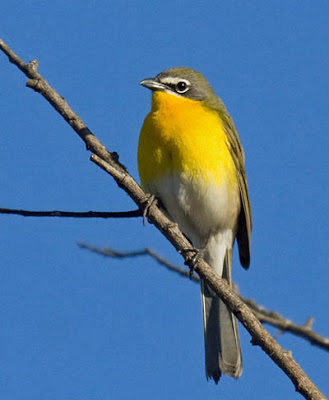 |
| Yellow-breasted Chat. Greg Gillson. |
These birds are greenish above with bright yellow breast and white belly. They have a dark mask bordered with white.
These birds live in tangles and wet woods.
Yellow-breasted Chats are summer residents throughout much of Texas, and spring and fall migrants throughout.
Wrapping Up
Texas boasts huge numbers of colorful birds. Here are some of my other favorites:
Texas boasts an incredible array of colorful birds, making it a paradise for birdwatchers and nature enthusiasts. Here are some of the most vibrant feathered friends you might encounter in the Lone Star State:
Painted Bunting: This dazzling songbird is considered one of the most beautiful birds in North America. Males sport a kaleidoscope of colors – blue head, green back, red breast, and yellow throat – making them truly breathtaking. Look for them in brushy areas, edges of woodlands, and gardens.
Green Jay: This lively resident of southern Texas brings a splash of tropical vibrancy to the state. With its turquoise back, bright yellow head, and black mask, the Green Jay is a showstopper in riparian habitats and dense forests. Its raucous calls add to its unique character.
Lazuli Bunting: These charming sparrows dress in striking blue attire, with males boasting rich azure bodies and white wing bars. Look for them in open scrublands, grasslands, and even backyards, where they visit feeders. Their sweet songs are a delight to hear.
Western Tanager: These summer visitors from the West bring a flash of fire to Texas forests. Males stun with their bright orange bodies, black wings, and yellow heads. Females display a more olive tone but still retain the vibrant wing markings. You can find them nesting in coniferous forests and enjoying fruit trees.
Frequently Asked Questions
What is a red bird that is not a cardinal in Texas?
Texas is home to a diverse range of red birds beyond the iconic Northern Cardinal. Here are a few possibilities depending on location and habitat:
Brighter Reds:
- Summer Tanager: This striking summer visitor boasts a fiery orange body, jet black wings, and tail. Males are easily spotted in the canopy of eastern Texas forests, whereas females are a slightly duller orange-brown.
- Scarlet Tanager: Another vibrant summer visitor, but this one prefers wooded edges and fields. Males sport a brilliant scarlet body, black wings, and tail, while females offer a more muted olive-green with red tinges.
- Painted Bunting: Arguably one of North America’s most beautiful birds, the male Painted Bunting stuns with its kaleidoscope of colors – blue head, green back, red breast, and yellow throat. Look for them in brushy areas, edges of woodlands, and gardens.
Reddish Tints:
- Pyrrhuloxia: This cardinal relative showcases a grayer plumage with reddish tinges, resembling a muted cardinal. They favor arid regions with thorny shrubs and cacti.
- Northern Flicker: While primarily brown, this woodpecker species has a bright red nape and rump that’s easily visible in flight. Find them in woodlands, parks, and even backyards.
- Vermilion Flycatcher: This fiery little flycatcher lives up to its name with its bright orange-red body. Males often perch prominently, displaying their plumage to attract mates. Look for them in open woodlands, riparian areas, and even mesquite thickets.
What are the tiny yellow finches in Texas?
Texas boasts a delightful variety of tiny yellow finches, flitting through trees and shrubs with their vibrant plumage. Identifying them can be tricky, but here are some possibilities based on size and other features:
Most Likely:
-
Lesser Goldfinch: The most abundant yellow finch in Texas, these charming birds sport a bright yellow underside, black wings with white wing bars, and a green back. Males have a black cap in breeding season. Look for them in open fields, meadows, and backyards.
-
Pine Siskin: Slightly smaller than Lesser Goldfinches, Pine Siskins prefer coniferous forests and woodlands. They are streaked brown and yellow, with a yellow rump and wing bars. Watch out for their distinctive “tsee-see” call.
________________________________________________________________________________________________
Related Articles:
See photos and learn about the most common backyard birds in Texas, regardless of color.
See photos and learn what to feed winter birds in Texas.
Here’s a quick tutorial of how I would teach you to identify birds: 7 Steps to Identify Birds!
Birds with red heads in North America.
Yellow-and-black birds in North America.










